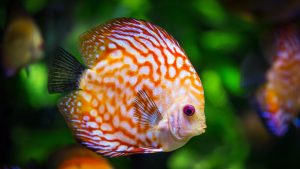Eubalaena glacialis
Eubalaena glacialis The North Atlantic right whale (Eubalaena glacialis, Müller, 1776) is a species belonging to the Balaenidae family. Systematics
Read more
 Fish are a diverse group of basically aquatic vertebrate organisms, covered in scales and equipped with fins, which breathe through their gills.
Fish are a diverse group of basically aquatic vertebrate organisms, covered in scales and equipped with fins, which breathe through their gills.
This large group, belonging to the Pisces superclass, contains over 32,000 known species which, in turn, cover almost 50% of the total species of the subphylum vertebrata.
The fish swim thanks to the fins, which are formed by folds of the skin supported by small sticks, called rays.
The fish use their fins as oars to push themselves into the water.
Interesting is what concerns the body temperature of the fish; this is the same as the water in which they live; if the water temperature changes, so does that of the body. Animals that have a temperature similar to that of the surrounding environment are called cold-blooded animals or ectotherms.
Generally, fish have a tapered body, which allows them to move quickly in the water.
Almost all fish have the body covered with small, almost transparent sheets, called scales, which have a protective function. The flakes are arranged one on top of the other, like the tiles on a roof; they are formed of a substance similar to that of nails, and grow as the fish grows.
Furthermore, the fish breathe through the gills, small fringed red plates, located on the sides of the head. The red color of the gills is due to the presence of numerous blood vessels. The fish opens its mouth to swallow water, then pushes it towards the gills, which are responsible for extracting the oxygen. Oxygen passes to the blood and blood vessels carry it throughout the body. At the same time, again through the gills, the fish expels carbon dioxide.
From the food point of view, most of the fish are carnivorous; the preys are invertebrate animals, small or large, and insect larvae. There are also herbivorous fish, which feed on algae and other vegetables. Some are filter feeders, like the whale shark, and swallow microscopic plants and animals that float in the water.
As for reproduction, most fish use external fertilization: the eggs, that is, are fertilized outside the mother’s body. The males get close to the females; when these release the eggs in the water, the males emit the spermatozoa on them and fertilize them. Most fish expel a very large number of eggs into the water.
Fish represent, in the trophic chain, a fundamental link and a very important source of food for man. Over 20% of the animal protein consumed in the world comes from fish.
Guido Bissanti
Eubalaena glacialis The North Atlantic right whale (Eubalaena glacialis, Müller, 1776) is a species belonging to the Balaenidae family. Systematics
Read moreGonostoma denudatum The spinymouth or imperial anciova (Gonostoma denudatum Rafinesque, 1810) is a deep sea fish belonging to the Gonostomatidae
Read moreCyclothone braueri The Garrick or Brauer’s Bristlemouth (Cyclothone braueri Jespersen & Tåning, 1926) is a very small abyssal fish belonging
Read moreGaleus melastomus The Blackmouth catshark (Galeus melastomus Rafinesque, 1810), is a small deep-sea shark belonging to the Scyliorhinidae family. Systematics
Read moreArgyrosomus regius The meagre or croaker, jewfish, shade-fish, sowa, kir, corvina, salmon-bass, stone bass, (Argyrosomus regius Asso, 1801) is a
Read moreOphichthus rufus The rufus snake-eel (Ophichthus rufus Rafinesque, 1810) is a marine bony fish belonging to the Ophichthidae family. Systematics
Read moreApterichtus caecus The European finless eel (Apterichtus caecus Linnaeus, 1758) is a marine bony fish belonging to the Ophichthidae family.
Read moreApterichtus anguiformis The lesser grass snake (Apterichtus anguiformis, W. K. H. Peters, 1877) is a marine fish belonging to the
Read moreOphichthus ophis The spotted snake fish or spotted snake eel (Ophichthus ophis Linnaeus, 1758) is a marine fish belonging to
Read moreDalophis imberbis The sea snake or mizzen snake (Dalophis imberbis Delaroche, 1809) is a marine bony fish belonging to the
Read more